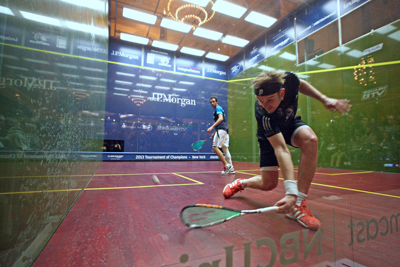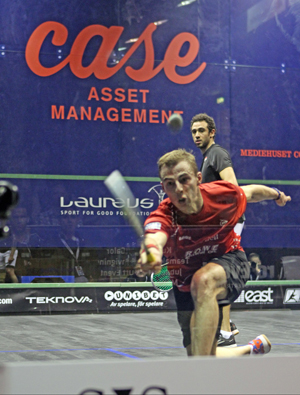By Peter Nicol
I was always classed as a defensive, counter-attacking player. However, this was not how I saw myself at all—well not exactly. I understood that my best way of competing and beating other top players was to use my strengths and protect my weak areas. Sounds obvious but if I played a lower ranked player, I was able to play a more expansive, short, attacking game and still manage to win. This was not the case against other top ranked players who were able to take advantage of the inadequacies in my short game.
So what I did was attack the back of the court, not just hit the ball into that area randomly or because you are supposed hit into that area before going short. This is a common fault for all players; the nondescript deep shot. Also, because of the changes in style of play over the last few years, an easy ball at the back of the court is likely to be punished just as severely as an easy ball at the front of the court. Therefore, it has become necessary to be much more aggressive hitting into the back court.
My coach, Neil Harvey, would regularly comment when coaching me between games that I needed to make sure I hit with purpose into the back corners, whether it be hard, soft, slow or high. I use the terminology ‘with purpose’ a lot to describe how to hit a certain shot, meaning the shot has, well, meaning. In this case it is an attacking, aggressive shot. The difference when I attacked into the back corners was immediate and changed the nature of the rally and, therefore, game. I’d sometimes play a first game, be completely outplayed by my opponent and only then, at the start of the second game, begin to properly focus on attacking the back of the court. The whole match would change and I regularly won in four games with the last couple being very comfortable.

There are several aspects of the game that change when you manage to start attacking your opponent deep in the court, and I knew my execution of the shots were working when:
•Positioning—I was getting to the T and in front of my opponent more often than not.
•Time—I had more time to recover to the T and then to get onto the subsequent balls.
•Volleying—the extra time gave me the ability to really focus on volleying and applying more pressure.
•Going short—as my opponent was deeper in the court, my short game did not need to be so precise, so I had more options attacking to the front of the court.
Conversely, my opponent would be feeling the opposite:
•Positioning/T—feeling out of position most of the time and rarely getting to the T with control.
•Time—as with above, my opponent would have less time to recover and was always then on the back foot.
•Pressure—my opponent would feel the build up of pressure and play a short ball too early, or from the wrong position, giving over even more control to me.
•Mistakes—my opponent would then start to make mistakes and gift points to me because of the pressure
The last point was something that happened a lot, and I loved getting 5/6 points a game from mistakes. This made it seem like I was never really attacking and relying on my opponents unforced errors to win, but was actually quite the contrary—I was pushing my opponent into those mistakes by applying pressure to the back of the court.
The game now is very much about attacking, but the viewer sometimes mistakes the style of game. Ramy Ashour is an incredible front court attacking player but, next time you watch him play, check out his attack to the back court—it’s really special too!





